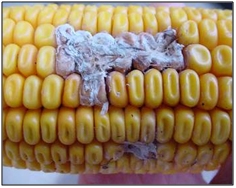Mar 14 2017
GM Corn To Prevent Deadly Toxin
 Aflatoxin is a serious food contaminant that causes both acute and chronic illness in animals and humans. It was first discovered in 1960 when 100,000 turkeys in the UK died over the course of a few months. Their deaths were tracked to a nut-based feed that was contaminated with a newly discovered toxin, named aflatoxin.
Aflatoxin is a serious food contaminant that causes both acute and chronic illness in animals and humans. It was first discovered in 1960 when 100,000 turkeys in the UK died over the course of a few months. Their deaths were tracked to a nut-based feed that was contaminated with a newly discovered toxin, named aflatoxin.
Aflatoxin is a group of 20 toxins produced by a fungus, Aspergillus species. According to Food Safety Watch:
Aflatoxins may be present in a wide range of food commodities, particularly cereals, oilseeds, spices and tree nuts. Maize, groundnuts (peanuts), pistachios, brazils, chillies, black pepper, dried fruit and figs are all known to be high risk foods for aflatoxin contamination, but the toxins have also been detected in many other commodities. Milk, cheese and other dairy products are at risk of contamination by aflatoxin M. The highest levels are usually found in commodities from warmer regions of the world where there is a great deal of climatic variation.
Corn is perhaps the biggest source of aflatoxin contamination. It is estimated that 16 million tons of corn are disposed of each year due to aflatoxin contamination. The toxin is highly stable and can survive most types of food processing.
Acute toxicity can result in death when severe. Chronic toxicity is difficult to detect, and the most common effect is liver damage and increased risk for liver cancer.
Many techniques are used to minimize contamination, but even with these methods aflatoxin is a huge source of food waste and an important cause of human illness, especially in developing countries.
Preventing Aflatoxin
All of the above is why Monica Schmidt, a plant geneticist at the University of Arizona, set her sights on aflatoxin. Schmidt’s idea was very clever – Aspergillus exchanges small amounts of genetic material with host plants during infection. This opens the door to potentially exploit a new technique known as Host Induced Gene Silencing, or HIGS.
Schmidt inserted a small amount of modified Aspergillus RNA into the genome of a corn hybrid. When that corn species is infected with Aspergillus it transfers that RNA to the infecting fungus, turning off its ability to produce aflatoxin.
Schmidt was able to get a $100,000 grant from the Bill and Melinda Gates Foundation to do her initial research, which was very successful. She reports that in her initial research the modified corn was 100% effective at suppressing aflatoxin production.
Research so far shows that the GMO corn is “substantially equivalent” to the hybrid from which it derives. There does not appear to be any other changes to the corn genome other than the new desired trait. Further, this technique can be applied to a number of other crops, such as peanuts, that are vulnerable to aflatoxin contamination.
Her research, however, ran into a snag. She applied for a phase 2 grant from the Foundation, and was denied. That, in itself, is not remarkable. According to the foundation only 10-12% of phase 1 grants are given phase 2 grants. But there is reason to believe that Schmidt was turned down not because her research was unworthy, but simply to avoid the controversy surrounding GMOs.
A proposal for additional funding was turned down after two reviewers for the foundation called it great work, but questioned whether the foundation wanted to get involved in genetically modified organism research. One reviewer gave no recommendation after saying, “This is great. This is fantastic. This is the person who’s going to do it,” Schmidt said.
A second reviewer recommended against funding, saying, “It’s going to have public acceptance issues because it’s GMO,” Schmidt said.
If this is a fair assessment, that is a sad example of the chilling effect that pseudoscience and fake controversies can have on scientific research. This is research in the public interest, not corporate research. The purpose of this particular GMO is to improve food safety, save lives, and reduce food waste.
In this case there didn’t even have to be any specific opposition to Schmidt’s research. The “toxic” environment of anti-GMO hysteria was enough to make funding such research too controversial to bother.
This is not an isolated incident, or issue. I know world-class autism scientists who refuse to talk to the press about autism, because any mention of the word will result in their lives being ruined by harassment from the anti-vaccine crowd. Kevin Folta has certainly paid the price for his science advocacy.
Those of us who have been willing to take on controversial issues have all faced harassment to one degree or another. That is, unfortunately, the nature of fanaticism. Anti-GMO (or anti-vaccine, or anti-fluoridation) activists think they are saving the world from the forces of evil. To them this justifies extreme measures, such as vandalizing research, or making a hit list calling for the murder of journalists whose reporting they don’t like.
They are also extremely vulnerable to con artists who can easily manipulate their fears, scientific illiteracy, and simplistic world view.
Anyone who disagrees with them is, at best, a shill. At worst they are baby-killing Nazis.
I can understand why the Gates Foundation (or anyone) does not want to become the target of such harassment, but I disagree with caving to these tactics. The fact that they use character assassination, mudslinging, and harassment is all the more reason to stand firm against them, and to support and promote good science.
I hope Schmidt gets the funding she needs, and the world gets to benefit from her scientific research.






